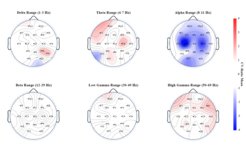Using EEG data to differentiate between schizophrenia and depression
Researchers found distinct neural signatures
Researchers at the Max Planck Institute of Psychiatry analyzed EEG recordings with supervised machine learning to identify distinct neural signatures of schizophrenia, major depressive disorder, and abnormal aging. The analysis showed that it is possible to differentiate between these mental health conditions using resting-state EEG, and also introduced a novel normative Electrophysiological Age Gap Estimation (EphysAGE) model to measure brain aging processes in healthy people and patients with neuropsychiatric conditions.
Key highlights of the paper:
- Robust classification models separating schizophrenia and depression from healthy controls using EEG data.
- Identification of alpha power decreases as a predictive feature for schizophrenia and depression.
- The development of the EphysAGE model, revealing how aging processes affect the brain differently in mental health disorders.
- Insights into how aging impacts diagnostic separability, paving the way for potential clinical biomarkers.

This figure presents topographic maps showing how effectively different brainwave patterns, across various frequency ranges, distinguish schizophrenia patients from healthy individuals. The frequency ranges include delta (1–3 Hz), theta (3–7 Hz), alpha (8–11 Hz), beta (12–19 Hz), low gamma (20–49 Hz), and high gamma (50–70 Hz). The color intensity indicates prediction strength; deeper colors represent stronger predictive power. Reduced activity in the alpha frequency band stands out as a strong indicator of schizophrenia-like traits, as highlighted on the maps.
© 2024, © Elif Sarisik and David Popovic 2024. Published by Oxford University Press on behalf of the Maryland Psychiatric Research Center.
